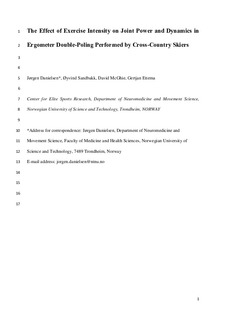| dc.contributor.author | Danielsen, Jørgen | |
| dc.contributor.author | McGhie, David | |
| dc.contributor.author | Sandbakk, Øyvind | |
| dc.contributor.author | Ettema, Gertjan | |
| dc.date.accessioned | 2017-12-14T15:38:25Z | |
| dc.date.available | 2017-12-14T15:38:25Z | |
| dc.date.created | 2017-11-30T13:39:16Z | |
| dc.date.issued | 2017 | |
| dc.identifier.citation | Human Movement Science. 2017, 57 83-93. | nb_NO |
| dc.identifier.issn | 0167-9457 | |
| dc.identifier.uri | http://hdl.handle.net/11250/2471985 | |
| dc.description.abstract | The purpose of this study was to examine the effect of increasing exercise intensity on the role of joint powers in ergometer double poling (DP), while taking specific dynamic constraints into account. One main question was whether lower-body power contribution increased or decreased with increasing intensity. Nine male Norwegian national-level cross-country skiers performed ergometer DP at low, moderate, high and maximal intensity. Kinematics, and ground (GRF) and poling (Fpoling) reaction forces were recorded and used in link segment modeling to obtain joint and whole-body dynamics. Joint powers were averaged over the cycle, the poling (PP) and recovery (RP) phases. The contribution of these average powers was their ratios to cycle average poling power. At all intensities, the shoulder (in PP) and hip (mostly in RP) generated most power. Averaged over the cycle, lower-body contribution (sum of ankle, knee and hip power) increased from ∼37% at low to ∼54% at maximal intensity (p < .001), originating mostly from increased hip contribution within PP, not RP. The generation of larger Fpoling at higher intensities demanded a reversal of hip and knee moment. This was necessary to appropriately direct the GRF vector as required to balance the moment about center of mass generated by Fpoling (control of angular momentum). This was reflected in that the hip changed from mostly absorbing to generating power in PP at lower and higher intensities, respectively. Our data indicate that power-transfer rather than stretch-shortening mechanisms may occur in/between the shoulder and elbow during PP. For the lower extremities, stretch-shortening mechanisms may occur in hip, knee and trunk extensors, ensuring energy conservation or force potentiation during the countermovement-like transition from body lowering to heightening. In DP locomotion, increasing intensity and power output is achieved by increased lower-body contribution. This is, at least in ergometer DP, partly due to changes in joint dynamics in how to handle dynamic constraints at different intensities. | nb_NO |
| dc.language.iso | eng | nb_NO |
| dc.publisher | Elsevier | nb_NO |
| dc.rights | Attribution-NonCommercial-NoDerivatives 4.0 Internasjonal | * |
| dc.rights.uri | http://creativecommons.org/licenses/by-nc-nd/4.0/deed.no | * |
| dc.title | The effect of exercise intensity on joint power and dynamics in ergometer double-poling performed by cross-country skiers | nb_NO |
| dc.type | Journal article | nb_NO |
| dc.type | Peer reviewed | nb_NO |
| dc.description.version | acceptedVersion | nb_NO |
| dc.source.pagenumber | 83-93 | nb_NO |
| dc.source.volume | 57 | nb_NO |
| dc.source.journal | Human Movement Science | nb_NO |
| dc.identifier.doi | 10.1016/j.humov.2017.11.010 | |
| dc.identifier.cristin | 1520928 | |
| dc.description.localcode | This is the authors' accepted and refereed manuscript to the article. Locked until 24 November 2019 due to copyright restrictions. | nb_NO |
| cristin.unitcode | 194,65,30,0 | |
| cristin.unitname | Institutt for nevromedisin og bevegelsesvitenskap | |
| cristin.ispublished | true | |
| cristin.fulltext | postprint | |
| cristin.qualitycode | 1 | |

